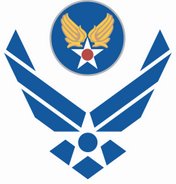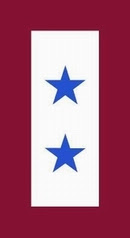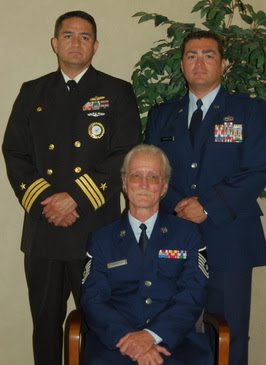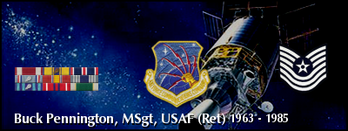... you get a re-run. This one's over five years old so it will prolly be new to most of you, seein' as how there are only about two of you Gentle Readers who have been with me since 2006. This lil bit o' nostalgia was prompted by blog-bud Glenn, who posted a lot o' pics of the Edwards AFB air park... one such bein' an F-101 Voodoo. I had a close encounter of the underwear changing kind with a Voodoo in the way-back...
Saturday, March 18, 2006
Old Computer Tech and a War Story
Lileks has some great old computer advertising promotional photos from the ‘60s and ‘70s here. Browsing through those old photos made me a bit nostalgic for the old USAF Semi-Automatic Ground Environment (SAGE) system, the nation’s air defense system from 1963 until 1983. (More on SAGE, including some pretty cool old photos, here. Click on the “SAGE” links in the left hand sidebar.) I enlisted in the AF in 1963 and spent almost half of my life working in the SAGE system, albeit on the sensor (radar) end, not the computing end. Here’s a thumbnail description of SAGE:By the time the system was fully deployed in 1963, according to MITRE, "the 24 SAGE Direction Centers and three SAGE Combat Centers were spread throughout the U.S. Each was linked by long-distance telephone lines to more than 100 interoperating air defense elements, requiring system integration on a scale previously unimagined. At the heart of each center was a new large-scale digital computer that had evolved from MIT's experimental Whirlwind computer of the 1950's. The largest real-time computer program of that time, it automated information flow, processed and presented data to 100 operator stations, and provided control information to the weapons systems. This processed information, including aircraft tracks and identification, was presented to operators on a cathode ray tube -- one of the first uses of this device to display computer-generated data." Each Center was built around a huge A/N FSQ-7 computer with 60,000 vacuum tubes requiring 3 megawatts of power and running the largest computer program written up to that time, with 500,000 lines of code. This program used an area in system memory called COMPOOL that could be shared by several subroutines. This would become one of the founding concepts for the COBOL computer language. The communications devices from Burroughs allowed each center to communicate with other centers, creating one of the first practical computer networks.The air defense of the entire United States and Canada was based on a network of 22 “Direction Center” computers, each of which ran mere 500,000 lines of code. Your desktop machine has 40 million lines of code in its operating system, assuming you’re running Windows XP. We’ve come a long way, Baby!
If you followed that “here” link above, you’ll note the main page has a photo of an F-102 superimposed on a radar tower, with a clickable link called “Bubble Check.” Click that link! The pilot that wrote that piece describes the bubble checks he performed while up in Alaska and maintains that USAF pilots only did that sort of thing at remote sites where the possibility of civilian complaints was low to non-existent.
Hogwash.
I got the living BeJeebus scared out of me while at Lompoc AFS in the mid-60s by an F-101 pilot out of Oxnard AFB pulling an unannounced bubble check. Just to be clear, bubble checks had at least two purposes: one was to impress and entertain the troops at the radar sites, the second was to express displeasure with ground controllers who screwed up intercept vectors, causing the fighter jock to miss an intercept on an in-bound target. When the latter scenario happened, said displeased fighter jock would buzz the ground control intercept site, unannounced, usually lighting off the afterburner(s) in the process, which caused a helluva lot of racket and startled everyone within a couple thousand yards. Point made, and all that.
So, there I was, about 60 feet off the ground at the very top of the antenna of an AN/FPS-6 height finder radar which was situated on the edge of the “hill” the radar site was located on. Or, to put it another way, the radar tower overlooked a valley that was at least a couple of thousand feet wide and several hundred feet deep, the point being one could fly an aircraft through that valley and be beneath the elevation of the radar station.
It was a fairly warm and clear summer’s day and I was inspecting the antenna for cracks, a normal preventive maintenance routine. I caught a flash and a glint out of the corner of my eye, turned and looked over my shoulder and DOWN, right into the cockpit of an F-101 doing about 600 mph, 90 degrees to the ground, a mere 150 feet or less from my poor frail body. The pilot lit off the afterburners just as I caught the flash of the aircraft as it sped by and the entire antenna—including me, holding on for dear life—was rocked by a thunderous KA-BOOM-BOOM! The pilot stood that 101 on its tail as it passed over the search radar tower and shot straight up into the sky, disappearing in a matter of seconds.
As for me, I was left completely shaken, clinging to that antenna with a veritable death-grip. I was damned lucky I didn’t have to go home and change my pants after that event. And it took me about ten minutes or more to gain enough composure to climb down from the antenna. Bubble checks are impressive, indeed. Scary, too.
I did some minor editing to the above, such as removing dead links and adding the pic of the Voodoo (which sits on the prem at the AF Armament Museum at Eglin AFB). We weren't much on graphics back when we started out with this bloggin' thang.





.jpg)




That reminds me of....
ReplyDeletelookout training and the Phantom II (F-4) or a Crusader (F-8). The radar gang in CIC (combat information center) was responsible for instructing the lookouts on the ship. Most of the time when we operated with carriers it was as a picket some 75 miles or more from the carrier, but we were in constant contact with the CAP (combat air patrol) because we'd have at least one qualified air intercept controller on watch. Part of the fun of training lookouts was having the CAP buzz the ship at about 100 feet. Of course it was always with the permission of the CO, many times without anyone else being any the wiser until it was done.
v-word = squidie <- WTF?
My Dad was involved with Ma Bell at the SAGE site at Opheim, Montana back in the late fifties and early sixties. We lived in Malta as Mom taught school there with my maternal grandparents. We got to see and hear the Voodoos on occasion there. Plus on occasion the F-89 Scorpions out of Great Falls, Montana ANG had them for quite awhile.
ReplyDeleteAnd to Uncle Skip, you are on the blog roll/list at ORPO!
ReplyDeleteGoing to link this one!!!!!
ReplyDeleteGood 'ol Voodoo -- last close encounter was a a JO at an airshow in Halifax watching a pair of CF-101Bs doing a low alt/high speed run at the field. Very impressive up until they racked them into a hard turn -- and disappeared over the horizon...Still, along with the F-106 one of my favorite of the Century series and a hint at the F-4 to come.
ReplyDeleteNice article Buck :)
w/r, SJS
(does that make the tally 3 now?)
That pic there is a 2-seat F-101B interceptor, Buck. The 81st TFW@ RAF Bentwaters/Woodbridge in Suffolk, East Anglia (just outside city of Ipswitch & closer town of Woodbridge sitting on the river Deben) was equipped w. the F-101C single-seat fighter-bomber and had only just re-equipped w. F-4Cs(Bentwaters) &D models (Woodbridge--my old Sq, the 78TFS) a couple of years prior to my arrival.
ReplyDeleteYa know, Buck, thinking about how you spent your impressionable yoof working around leaky wave guides, I am impressed you had fathered such healthy youngsters!
ReplyDeleteUs ol' radar operators (LN-66 with leaky wave guides...) tended to have girl chirren, or none at all.
Skip: Heh. But if those guys were lookouts, shouldn't they have seen 'em comin'?
ReplyDeleteGlenn: I think I remember Opheim as bein' a Level III site, which is to say a back-up location for intercept controllers if the DC went down or got blown up. Not every radar site back in the day was capable of Level III ops. (Lompoc AS was a Level III site, too) I think it's cool yer Dad was involved in the bid'niz! And thanks for the link.
SJS: Thanks for the memory. The RCAF flew Voodoos a lot longer than we did, IIRC. Still and even, I used to love to watch that jet fly... from a distance. ;-)
Virgil: It was a B that buzzed me... remember, we were in ADC... ;-)
Darryl: We used to wear dosimeters when I first went into the field; the medicos would read us once a week and issue new dosimeters. The AF phased that out sometime around '65, IIRC. Our waveguides didn't leak... but you didn't wanna spend much time around the magnetron or klystron cabinets. Or on the antenna decks.
Cool story!
ReplyDeleteBuck - they were vectored in from the direction of the Sun. Besides, the lookouts were primarily for surface stuff. But, yeah, a well trained experienced lookout would see 'em coming. However not soon enough to do anything but report it, and that ol' can only had two Mk38 Mod0 5"/38 twin mounts for air defense... well maybe the noise of the gun would scare planes away.
ReplyDeleteORPO1 - thanks!
Moogie: Thank ya, Ma'am.
ReplyDeleteSkip: I read your link and wonder if those 5" guns actually ever had an AA "kill." Seems unlikely, even given the quoted figure of 1000 rounds/kill and that was in WW II, where the aircraft were a LOT slower. So, yeah: noise. ;-)